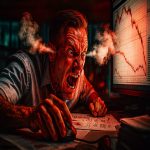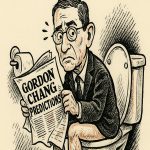
The Emotional Engine of Markets
Dec 2, 2025
Most traders talk about indicators the way gamblers talk about lucky dice, but the market does not care about their charts. Its pulse sits deeper, inside the raw animal emotion that drives every decision on the screen. The Fear and Greed Index captures that pulse with brutal precision. It records the tremors of fear before a selloff, the swelling arrogance before a peak, the moment when the crowd shifts from caution to hunger. Anyone who ignores it enters the market blind. Anyone who reads it with clarity gains an edge so sharp it feels unfair.
The index exposes how little rational thought exists in this game. Extreme fear tells you the crowd will soon exhaust itself. Extreme greed tells you the crowd will soon explode. The market is not a machine built on logic, it is a human storm made of nerves, doubt, envy, and panic. The few who can map that storm do not just protect themselves, they step into the chaos and take what the herd leaves behind.
The Psychological Blueprint Beneath the Index
This index looks simple, but it carries the architecture of collective mood inside one score from 0 to 100. Drop below 20 and the crowd buckles. Rise above 80 and the crowd loses its grip on reality. Seven signals build this number, each one measuring how fear or greed pushes traders off their center.
Volatility rises when nerves snap. The put or call balance tilts when traders scramble to hedge their nightmares. Momentum stretches when greed pulls prices far from sanity. Breadth reveals when the rally turns thin and hollow. Safe havens absorb money when survival instincts override ambition. Junk bonds swell when traders convince themselves the party cannot end. Volume exposes whether confidence is rising or terror is spreading.
These measures dissect emotion with surgical detail, turning instinct into data and panic into something you can quantify.
Fear, Greed, and the Violence of Timing
Markets do not collapse because of poor earnings, they collapse when greed inflates prices until a single spark ignites the pile. They do not soar because of good headlines, they soar when fear has crushed valuations so deeply that any breath of relief sends capital rushing back in. The Fear and Greed Index reveals that rhythm long before the crowd understands what is coming.
When the index sinks under 20, forward returns surge far above the norm, often reaching fifteen to twenty percent over the next year. When greed surges above 80, the future turns into a cliff. This inversion explains why Buffett’s rule cuts so deep. It is not philosophy, it is combat strategy. Step toward the market when others run. Step back when others swagger. Fear and greed are not side notes in timing, they are the whole mechanism, the gears that grind wealth into dust or spin it into something greater.
The Smart Money’s Playbook
The biggest market opportunities arise when emotion overwhelms reason.
When the Fear and Greed Index signals Extreme Fear, the herd is panicking. But history shows that’s exactly when the market bottoms out—not because of logic, but because fear exhausts itself. The same goes for peaks: euphoria collapses under its own weight.
✅ The Winning Strategy:
- Extreme Fear (<20) → Ignore the hysteria. Load up on high-quality assets.
- Extreme Greed (>80) → Step back. Take profits. Protect your capital.
Forget prediction. Focus on psychological inevitability. Master this, and you’re no longer reacting to the market—you’re controlling it.
Historical Patterns: When Emotional Extremes Created Extraordinary Opportunity
The Fear and Greed Index isn’t theory—it’s a roadmap to market extremes, exposing how collective emotion drives both historic buying opportunities and brutal collapses. The past proves one thing: when fear peaks, opportunity is born; when greed takes over, destruction follows.
2008-2009: The Greatest Buying Opportunity in a Generation
✅ Extreme Fear Index Reading: Below 10
Fear reached an unprecedented level at the depths of the 2008 financial crisis. The media fueled the panic with apocalyptic headlines like “The End of American Capitalism?” and “Is This the Next Great Depression?” Fear became self-perpetuating, triggering what behavioural economists call “availability cascades”—where emotionally charged scenarios dominate decision-making, regardless of actual probability.
The Herd: Selling in a blind panic. ? Smart Money: Accumulating assets at fire-sale prices.
Outcome: From its March 2009 bottom, the S&P 500 soared 70% in 24 months—a direct contradiction to the mass hysteria.
2018: Extreme Greed Sparks a Brutal Reality Check
✅ Extreme Greed Index Reading: Above 80
In January 2018, the index signaled unsustainable euphoria. Financial networks hyped the “synchronised global growth” narrative, pushing the idea that the market was in a “melt-up” with “no end in sight.” The greed-driven rally became a self-reinforcing loop—until reality intervened.
The Herd: Buying at peak valuations, chasing euphoria. Smart Money: Cashing out while the crowd lost control.
Outcome: Within weeks, the market corrected over 10%, proving once again that extreme optimism breeds devastating disappointment.
March 2020: Pandemic Panic & the Ultimate Contrarian Play
✅ Extreme Fear Index Reading: Record Lows (Below 10)
The COVID-19 crash was pure emotional chaos. Lockdowns, overwhelmed hospitals, and exponential infection curves dominated media coverage. Markets collapsed in freefall. The Fear and Greed Index signalled historic fear levels, reflecting the extreme uncertainty of the moment.
The Herd: Dumping stocks at any price. Smart Money: Stepping in while panic dictated irrational selling.
Outcome: Markets didn’t just recover—they delivered one of the strongest rallies in history, with the S&P 500 gaining over 70% in 12 months.
The Unbreakable Pattern: Fear & Greed as Psychological Extremes
Every major market turning point follows the same psychological sequence:
- Extreme Fear → Maximum Selling Pressure → Market Bottoms.
- Extreme Greed → Irrational Exuberance → Market Tops & Corrections.
The Fear and Greed Index exposes this cycle in real time, providing a tactical edge to investors willing to think against the herd.
The Media Amplification Effect: How Coverage Fuels Emotional Extremes
The Fear and Greed Index doesn’t just reflect investor psychology—it reveals how financial media manipulates sentiment, creating powerful feedback loops that intensify both fear and greed.
How Media Transforms Fear into Panic
When the index plunges below 20 (Extreme Fear), financial news channels go into full crisis mode:
❌ Graphics turn red, charts show steep declines, and anchors project visible concern. ❌ Dramatic language replaces neutral reporting (e.g., “plunging” instead of “declining”). ❌ Repetitive doom-loop narratives create “availability bias,” making investors perceive risks as greater than they actually are.
Case Study: December 2018 During the 2018 market correction, financial networks intensified the fear cycle. Dedicated “Markets in Turmoil” specials flooded the airwaves, constantly referencing the Fear and Greed Index’s extreme readings. The result? A self-reinforcing panic loop that drove even more selling, exacerbating the downturn.
How Media Hypes Greed into Euphoria
When the index surges above 80 (Extreme Greed), media narratives shift into mania mode:
Bullish headlines like “No End in Sight!” fuel excessive optimism. Experts predicting limitless gains flood the airwaves, creating FOMO. Retail investors, driven by euphoria, buy at the worst possible time.
Case Study: Late 2021 Tech Bubble The Nasdaq skyrocketed as media celebrated a “new era of innovation.” The Fear and Greed Index screamed Extreme Greed, yet investors ignored the warning signs—only to suffer when the bubble burst in 2022.
The Smart Money Playbook: Weaponising the Fear and Greed Index
Extreme Fear (<20) → Ignore the herd. Buy when others panic. Extreme Greed (>80) → Take profits. Protect your capital.
Most traders react. Winners anticipate. The Fear and Greed Index is a contrarian cheat code, exposing when markets are lying to you. Master it, and you’ll stop playing the game—
You’ll start controlling it.
Strategic Execution: Turning Market Sentiment into Investment Gains
The Fear and Greed Index isn’t just an indicator—it’s a weapon. Extreme readings signal opportunities to exploit emotional overreactions in the market.
Tactical Playbook:
- Extreme Fear (<20): Deploy capital in three phases. 40% into broad index funds (VOO, VTI) for core exposure. 40% into fundamentally strong stocks unfairly beaten down. Keep 20% in reserve for deeper market panic (<15).
- Options Strategy: Elevated fear spikes implied volatility. Sell cash-secured puts on quality stocks, collecting fat premiums while securing potential entries at deep discounts.
- Case Study (March 2020): MSFT put options yielded 25%+ annualized premiums at 15% below market price. This was not rational pricing—it was pure panic. Savvy traders harvested premiums and secured world-class stocks at fire-sale valuations.
Greed Management:
- Extreme Greed (>80): Systematic profit-taking. Trim winners, reallocate to undervalued sectors or build cash reserves. Selling into euphoria locks in gains and funds the next fear-driven buying spree.
- Structured Discipline: No predictions, just execution. Pre-set protocols force rational action when emotions tempt the opposite.
The Deeper Truth: Markets as Psychological Organisms
The Fear and Greed Index exposes a market myth—pricing isn’t purely rational. If it were, extreme sentiment-driven mispricings wouldn’t repeat like clockwork.
Key Insight: Market efficiency is adaptive, not absolute. Emotion-driven excesses create recurring opportunities. The index flags those moments with precision.
Philosophical Shift:
- From Prediction to Pattern Recognition: Stop guessing the future. Instead, recognize that mass psychology follows predictable cycles.
- Metacognition as Edge: Train yourself to observe your own emotional responses. When your fear or greed aligns with the index extremes, history suggests the opposite move is the winning play.
- From Pawn to Observer: The few who master emotional discipline systematically profit from the majority’s predictable overreactions.
This is the core advantage—understanding that markets aren’t driven by logic but by sentiment waves that the disciplined can ride for profit.












